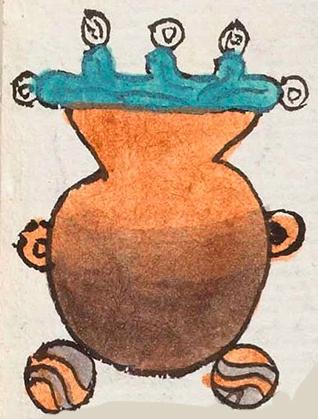atotonilli (Mdz28r)
This simplex glyph duplicates the place name, Huei Atotonilco, adding visual vocabulary to the collection. This glyph stands for hot water. We see a flared-mouth, round bottom, ceramic pot sitting on hearth stones. The pot has carbon on the portion near the hearth stones. Water runs along the top of the pot and spills over the sides a little bit. The water is turquoise blue, as usual, and it has waves or splashes that feature white turbinate shells and white water droplets/beads. The water also has black lines that suggest currents.
Stephanie Wood
This simplex glyph could also be considered a compound, given that it contains elements that are also glyphic in and of themselves--the stones (tetl), the water (atl), and the pot (comitl), with all their classic glyph-like characteristics (droplets and shells on the water and wavy lines on the stones). Atotonilco is likely a place with hot springs or thermal waters, having nothing to do with cooking, even if that visual is meant to bring forth the reading of someone boiling water on a hearth. The size of the pot varies in the Codex Mendoza, as Gordon Whittaker has pointed out, which results in the diverging place names Atotonilco and Huei Atotonilco (the latter, being Greater Atotonilco).
Stephanie Wood
Stephanie Wood
c. 1541, but by 1553 at the latest
Stephanie Wood
water, shells

atotonil(li), hot water, https://nahuatl.wired-humanities.org/content/atotonilli
totonil(ia), to heat something, https://nahuatl.wired-humanities.org/content/totonilia
a(tl), water, https://nahuatl.wired-humanities.org/content/atl
Stephanie Wood
Codex Mendoza, folio 28 recto, https://digital.bodleian.ox.ac.uk/objects/2fea788e-2aa2-4f08-b6d9-648c00..., image 66 of 188.
The Bodleian Libraries, University of Oxford, hold the original manuscript, the MS. Arch. Selden. A. 1. This image is published here under the UK Creative Commons, “Attribution-NonCommercial-ShareAlike 3.0 License” (CC-BY-NC-SA 3.0).

